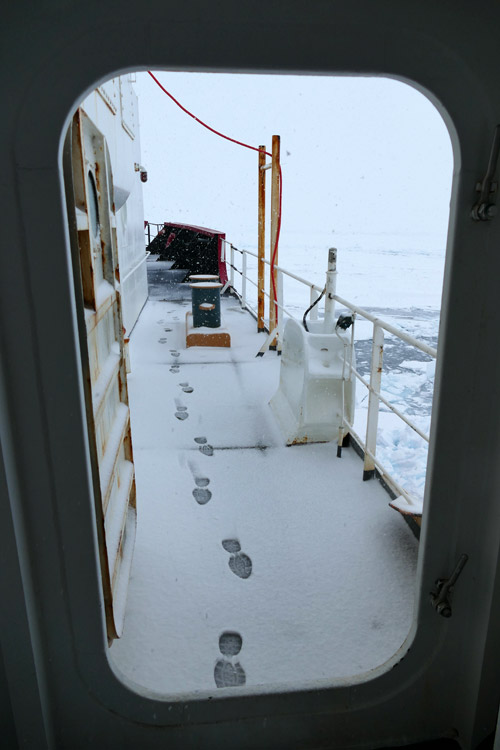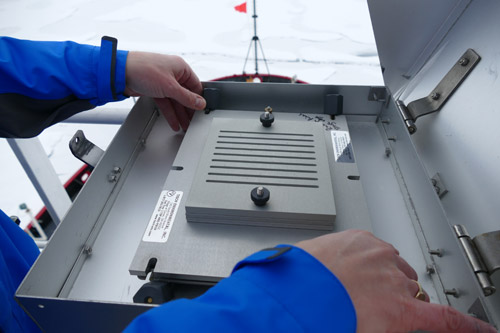Cruise Day 24
Speed 0 knots (kts)
Course N/A
Location Makarov Basin, approx. 145nm S. of the North Pole
Depth 3948 m
GO DEEPER DISCUSSION: (see previous journal for the questions.)
The gray areas adjacent to the coastlines on the map are less than 300 meters deep, so no temperature data is plotted there (the example graph was temperature at 300 meters.)
TODAY'S JOURNAL:
Yesterday evening the intermittent sunshine we'd been getting throughout the day was blotted out by increasing clouds, and when I stepped out to the deck this morning I was greeted with brisk wind and steady snowfall. We are stopped for a "Super Station", so-called because samples will be taken at many more depths than at a regular sampling station. We are expected to take about 57 hours to complete this station before we depart on the final northerly leg of the cruise. When Germany's Polarstern icebreaker gets to the same spot as today's super station they will repeat the sampling protocol, so this is also called a crossover station.

Back in July I wrote a journal about setting up the Healy in Seattle (Time to Get Busy!, July 23.) In it I included a video showing the installation of an array of aerosol sampling gear up on the flying bridge (essentially the roof of the ship's bridge over 70 feet above the waterline.) It felt pretty different working atop the bridge back then when the sun was out and the temperature was around 80° F. We've been collecting aerosol samples along the way since we left Dutch Harbor, and recently I caught up with Chris Marsay, Post-doctoral Research Associate at Skidaway Institute of Oceanography in Savannah, Georgia, as he changed the filters on the aerosol sampling gear. He, along with Co-Chief Scientist Bill Landing and Neil Wyatt, form the onboard aerosol sampling team.
AerosolsTiny solid particles or liquid droplets that remain suspended in the atmosphere for a long time. Aerosols are produced by natural processes or human activities, such as volcanic dust, sea spray, smoke from forest fires, particles emitted during the burning of fossil fuels, etc. are particles in the air. They could include dust, soot, volcanic ash, chemicals in particle form, etc. A major question that GEOTRACES is trying to address on cruises such as this is to find inputs of trace metals into the world's oceans. One such pathway involves aerosol particle deposition into the ocean. Particles can just fall into the water, or be brought down with precipitation such as rain or snow. The aerosol samplers we have up on the flying bridge are essentially big blower motors that pull air through a filter plate. They are enclosed in sheltered aluminum housings that look kind of like silver mailboxes. Different types of filters can be clamped down on the filter plates, and as air flows through them the particles are trapped for later analysis. The samplers only run when the wind is coming from a sector within 60° of either side of the bow. If the wind leaves this clean sector, or drops to unacceptable speeds, the blowers automatically shut off (a wind vane and anemometer relay this information to a power controller.) This is to keep ship-generated contaminants such as engine exhaust from entering the filters. When the samplers are running they sound like big vacuum cleaners. Every three days or so, Chris climbs up to swap out the old filters for new ones.
There are three types of filters being used in the aerosol samplers. Two of the types fit in the same 47mm-diameter round holders- one is made of paper and the other glass fiber. The paper filters are used for trace metal analysis and the glass fiber filters are in play for mercury, organics, and nitrogen isotopes. Samples can be extracted from these filters in a few different ways. One is to digest the paper filters with acid. The resulting solution is analyzed with an Inductive Coupled Plasma Mass Spectrometer (ICPMS.) This device ionizes a sample with argon plasma, and separates isotopes in the sample by mass as they are accelerated through an intense magnetic field. The instrument is very large, so we don't have one in the science space aboard Healy. It is also highly precise and can return the exact number of each atom of each isotope in a sample. At around $500,000 they aren't cheap, either. Samples that will undergo this analysis are sealed in containers and kept frozen until they can be sent to labs on shore. Glass fiber filters are also delivered to labs back home for off-ship analysis. Another way the paper filters are analyzed is to leach them in ultra-pure water and in seawater taken from the same location as the particle sampling to determine how solubility of various trace metals changes depending on the local conditions. This analysis is being done on board during the cruise.

The third type of filter looks quite different. It is a gray housing with slots in it and a stack of thin flat filter plates underneath. This apparatus is designed to catch the largest particles on the top layer and the smallest ones on the bottom layer with intermediate size fractions in the successive filters in-between. These sampled filters go through the same acid digestion and ICPMS analysis, but their results can be compared to each particle size fraction.

GO DEEPER!
If you look at yesterday's weather you'll see it was over 10° F colder than it is today. Yet today it is cloudy, windy, and snowing. Why would it warm up significantly when the snowy weather arrived?
Aloft Con web cam updated every hour
That's all for now. Best- Bill


Comments